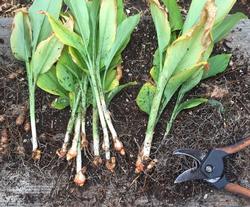Turmeric
Turmeric has been utilized for many centuries as a spice, a yellow-orange food coloring, and an ingredient in traditional medicine.
While typically seen in dried, powdered form, turmeric is also used fresh, similar to ginger.
How to grow
Turmeric is winter hardy to USDA Zones 8-11 (Santa Clara County ranges from 9a to 10b) and prefers hot summers and high humidity. Rhizomes can be purchased from a garden supply store, but fresh, plump rhizomes from the grocery store can also be planted. Before planting, cut rhizomes into pieces that are 1–3" long, making sure each piece has multiple healthy-appearing "buds". Let the pieces dry for a day or two to help prevent rot. Plant with a bud pointing upwards, about 2–4" deep.
- Type: Perennial, will go dormant in winter
- Light: Full sun to partial shade
- Soil: Well drained
- Water: Medium. Keep soil moist but not wet. Water sparingly until new growth begins, to avoid rot.
- Size: 3–4' high, 3–4' wide
When to plant/propagate:
- Plant rhizomes in early spring
- Can propagate by division
Harvesting
- Harvest mature turmeric rhizomes in late fall to early winter
- Gently dig out and harvest the rhizomes, leaving some in the soil if you want them to grow back the following spring
- Unpeeled fresh turmeric may be stored in a plastic bag in the refrigerator for several weeks. Freeze or dry to keep for longer.
Indoors: Turmeric can be grown indoors, although it may go dormant due to cooler temperatures and lack of sunlight in the winter. Do not water if dormant, until growth resumes in the spring.
More information
- Curcuma longa, Missouri Botanical Garden
- Growing Ginger and Turmeric Indoors, University of Vermont







